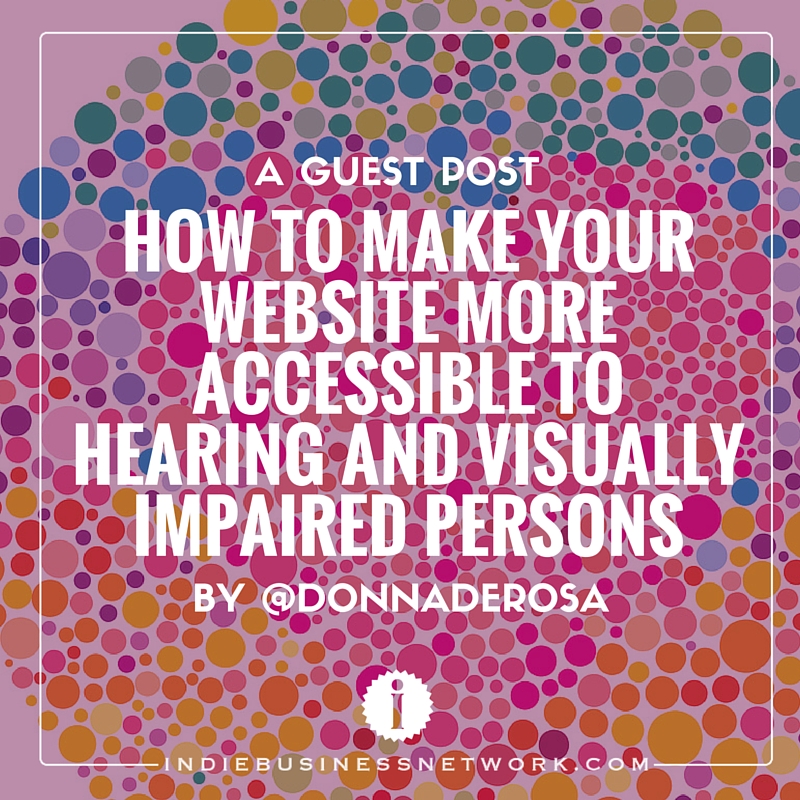
I recently attended WordCampUS, a 2-day conference focusing on everything WordPress. While the name of the event was WordPress specific, the conference was not. The speakers shared tips to help people attract more happy visitors to any kind of website.
Designing your website to be accessible to as many people as possible is key if you want to be successful online. Not everyone accesses your site in the same way. Some people have older computers or outdated browsers, and many use a mobile phone for everything. Others may have a disability that makes it difficult to access the content on your website.
Since every entrepreneur would like for as many people as possible to easily navigate their website, I am excited to share these tips to help you make your website more accessible to hearing and vision impaired persons.
How to Make Your Website Accessible to Hearing and Vision Impaired Persons
-
- Color blindnessMore than 4% of adults in the US are color blind, meaning they cannot see that certain text is highlighted on your website. A color-blind person may see red as a grayish green color.
Think about contrast as well as color when designing your site or even your promos. If you have a big box on your site that calls out a sale or promotion, you might think a bright red background with white text will really pop. For most people this is true. But a color-blind person may see a gray box that blends in with the rest of your site.
Backgrounds with too much texture can also make text appear washed out as the text tends to blend in with the background.
There are plug-ins available that can demonstrate what a color-blind person will see. For example, the Google Chrome Spectrum Extension allows you to instantly test your site page with different types of color vision deficiency.
- Color blindnessMore than 4% of adults in the US are color blind, meaning they cannot see that certain text is highlighted on your website. A color-blind person may see red as a grayish green color.
-
- Blindness or low visionMany people with vision impairment issues use screen readers, which use speech synthesizers to read aloud the text displayed on a computer screen. These programs read headlines and main body copy, along with the alternate and link text on photos. Properly label your images with alternate text that describes your photo. Do not use your company name or the blog post or page title because neither tell a vision impaired person about the image on the screen.
Your alternate text is also read by search engines, so including it adds another dimension of relevancy to your site content.
This advice also applies to link text. Keep anchor text on your links clear and to the point. For example, instead of “click here,” be specific about what action you want the reader to take. This will help people use your site more efficiently.
- Blindness or low visionMany people with vision impairment issues use screen readers, which use speech synthesizers to read aloud the text displayed on a computer screen. These programs read headlines and main body copy, along with the alternate and link text on photos. Properly label your images with alternate text that describes your photo. Do not use your company name or the blog post or page title because neither tell a vision impaired person about the image on the screen.
-
- Deafness or hearing lossAbout 15% of Americans aged 18 and over report some trouble hearing. That’s more than 37 million people. If you use video on your website, consider adding captions or making closed captions available to your viewers.
If you use audio or offer a podcast, include a written summary or a full transcript so more people can enjoy what you have to offer. A summary will also help with search engine optimization, because search engines scan text, not audio.
- Deafness or hearing lossAbout 15% of Americans aged 18 and over report some trouble hearing. That’s more than 37 million people. If you use video on your website, consider adding captions or making closed captions available to your viewers.
”
Donna DeRosa, Donna DeRosa Coaching
- Internet access generallyNot everyone has the latest, fastest computer, especially in developing countries. But did you know that more than 2 million people in the US still access the Internet through AOL's dial-up service? This services is a whopping 200 times slower than the average broadband connection, making it super important that you do all you can to ensure that your site loads quickly and is easy to navigate.
Designing your site to make it as user friendly as possible will also make it easier for smartphone and tablet users to do business with you.
In 2014, mobile usage surpassed desktop usage, so more people (including online shoppers!) are accessing the Internet on a mobile devices than on a laptop or desktop.
Make sure your site is mobile responsive so you don't miss out on those sales.
Question
What do you do to make your site content accessible to the hearing and vision impaired community, and to as many people as possible generally? Do share your tips and feedback in the comments below, or share on Facebook, Twitter, and LinkedIn.
* Source: Press Release: Nearly 1 in 5 People Have a Disability in the U.S., Census Bureau ReportsReport Released to Coincide with 22nd Anniversary of the ADA



